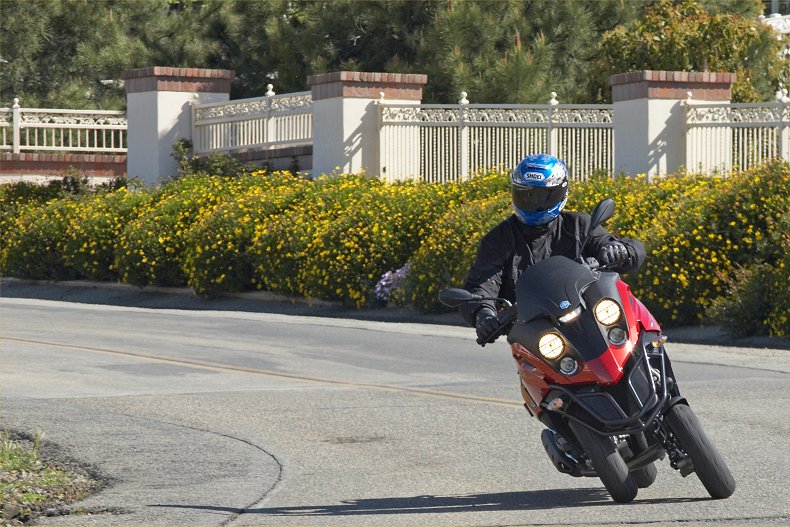
Piaggio’s MP3 scooter has been around in various forms for a while now, but not many people have seen one. That’s probably why the guy driving an old Camaro was ogling the machine obsessively as I made my way along the 91 freeway in L.A. First he’d pull alongside, then he’d jet ahead to check out the MP3’s front wheels in his mirror, then he’d drop back to take in the rear three-quarter view. Eventually he brought out his cell-phone camera and took a picture.
You can just see the guy showing his friends the image and saying things like: “The scooter had, like, three wheels, man. There were two mounted close together on the front, and the bike could still lean! It was weird.”
And it is a little weird. But thanks to the fascinating quadrilateral linkage that allows the dual suspension and steering systems on the front wheels to articulate independently, it’s an ingenious way to put more rubber on the road at the front of the machine, thereby providing more grip for cornering and braking. There’s a photograph in Piaggio’s training materials that shows the bike cornering across tramlines with one tire squarely on the slippery steel rail and the other firmly in touch with the asphalt. It speaks volumes.
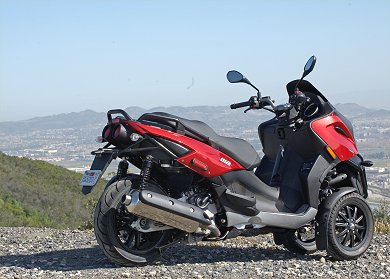
Another cool aspect of the leaning tandem front wheels is the electro-hydraulic locking mechanism that can be activated via a right-side button at near-stationary speeds (with the throttle shut) to keep the bike upright. There’s no need to use the center stand on the MP3 so long as you lock the front bogie and apply the parking brake. (Since the bike is equipped with a continuously variable transmission, or CVT, it’ll run downhill when the engine’s switched off.)
Although the MP3 family includes 125, 250, 400 and 500 models, we were keen to try out the biggest engine, assuming it would better bridge the differences between scooters (even so-called maxi-scooters like this one) and motorcycles, whose all-around versatility is well understood. We were particularly interested in the fuel consumption of the 500, because economy is one of the reasons people choose scooters.
We quickly learned that the liquid-cooled, fuel-injected 493cc, 40-horsepower, single-cylinder engine is quite capable of maintaining freeway speeds of 80 mph. Since its top speed is said to be 89 mph, there isn’t much acceleration left when cruising at that speed, but at least you aren’t being tailgated by impatient SUV drivers.
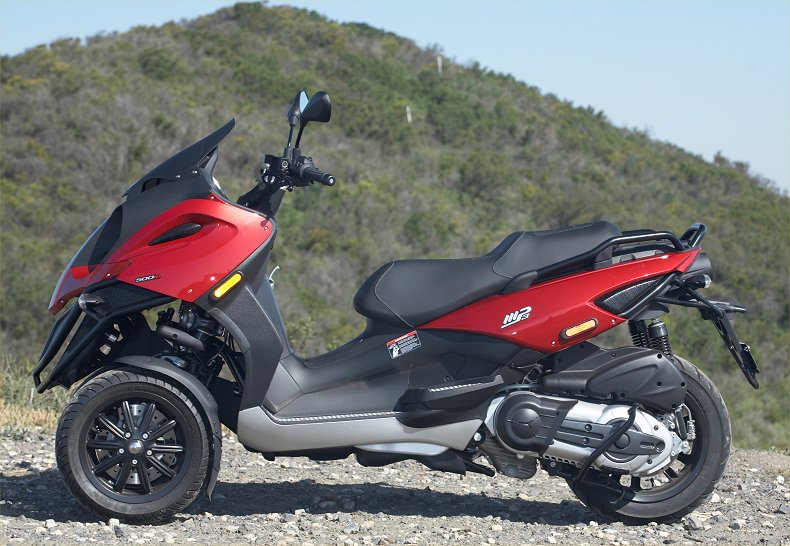
That output is certainly enough to leave the cars for dead when the lights change, even with an initial launch that feels a tad soft in the way many CVT-equipped scooters seem to be. But after a few yards of relatively lazy thrust, the engine reaches an rpm-range with good torque and just locks onto those revs as road speed increases. (Peak torque is 27 pound-feet at 5,000 rpm, with maximum power produced at 7200 rpm, which you seldom see on the tach.)
CVTs are always deceptive, because the engine speed stays relatively constant as real speed picks up, and you need to keep an eye on the speedometer for a better idea of your velocity. Since there is no clutch, as such, the left-hand lever controls the rear brake, while the right-hand lever activates the surprisingly powerful twin-disc front brakes. Even veteran motorcycle riders soon become accustomed to this setup.
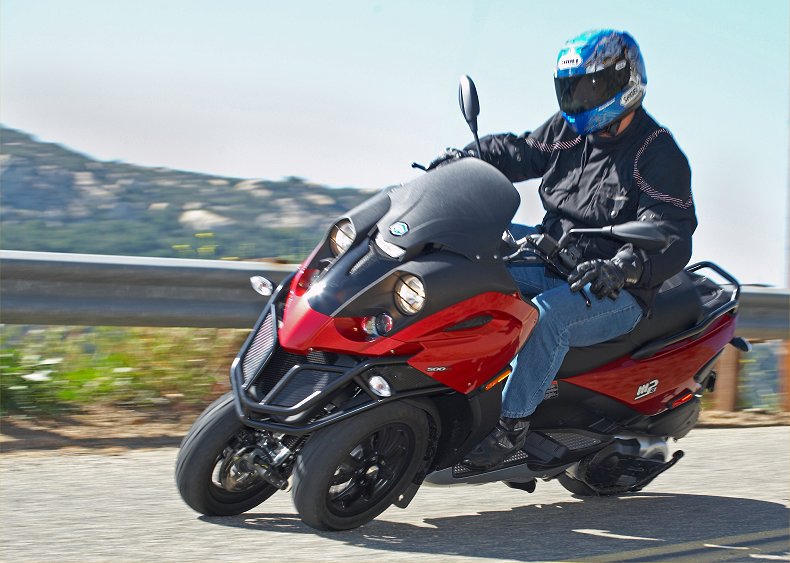
Before long you find yourself using both levers to slow the bike, then switching to the left lever to free the right hand so you can flick the front undercarriage-lock switch just as the bike stops moving. That way the MP3 holds itself upright, and you don’t have to put a foot down. It takes a little practice, but it’s a neat trick.
When you get it exactly right you can just sit there and enjoy the puzzlement of the onlookers until the light changes. Then you simply gas it and go, because the front suspension lock releases as soon as the bike begins to move.
Other than the novelty of the double front wheel, the MP3 offers many of the usual maxi-scooter amenities. There’s an anti-theft immobilizer, and a trip computer with various functions, among them a readout of ambient temperature. That’s always struck us as amusing on a machine whose operator sits outside.
There’s also a fairly capacious storage bin below the long and wide seat that you can stash stuff in while you go into Starbucks. This volume has apparently been compromised on the MP3 with the “big” 500 engine, since it will not take two helmets, and even one may be too tall to fit easily. Even so, the Piaggio boasts the around-town convenience conventional motorcycles do not have. It’s easy to see why motorcycle-averse commuters would pick a scooter instead. They’re simple to ride, and there’s no tall seat to swing a leg over.
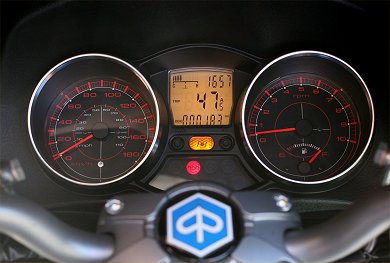
Furthermore, the MP3 steers and handles well, and the ride isn’t bad at all apart from a fairly insistent freeway hop on concrete roadways. As any road engineer will tell you, the cast slabs tip like shutters in response to the assault from big rigs, and the MP3 bobs like a bunny at the end of each of them.
Better to avoid long superslab rides. The bike is much better zipping around in the urban environment it was designed for. Not that the occasional canyon road is out of reach of this city slicker; the MP3 has 40-degrees of lean angle, and it weaves through winding sections of road with confidence. You soon feel the front end will never slide, no matter how hard you corner or brake. This shouldn’t be a surprise — a doubling of the front contact patch has this effect. This is something even experienced riders can appreciate when, for example, a need to aggressively apply the front brake mid-corner can be met without disaster.
One concern we have about the machine is the forced position of the seating, which places tall riders closer to the bars than is ideal, and reduces legroom at the same time. For riders of an average height, this is not really a problem. All in all, when you combine the MP3’s nimble nature with freeway-compatible performance and all-around convenience, this three-wheeler will handle a variety of real-world transport tasks. And despite our fairly high-speed trips with this vehicle (some of them two-up), the MP3 500 still returned 50 mpg.
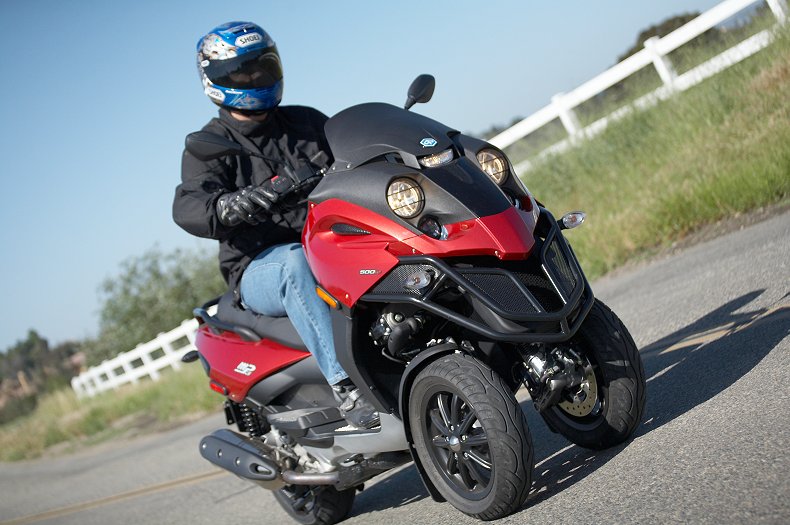
It certainly works a lot better than its odd appearance might suggest. Unfortunately, it also costs more than its odd appearance might suggest, proving that the double-wheeled front suspension is as expensive as it looks. Priced at $8,899, the Piaggio MP3 500ie may seem destined to lure mainly committed non-motorcyclists or former motorcyclists with a serious front-wheel-slide phobia. Despite this, the MP3’s doubling of front end traction is something experienced riders should sample, as well.
For more info and specs, visit Piaggio’s website here.





